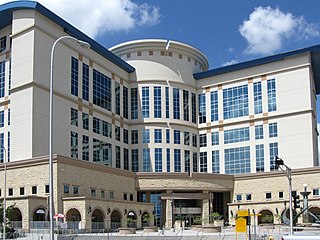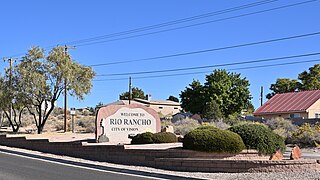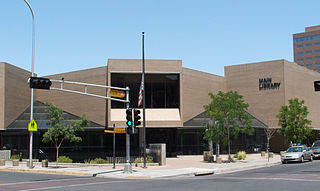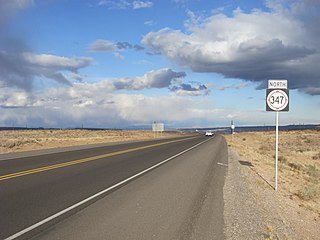
Albuquerque, also known as ABQ, Burque, the Duke City, and in the past 'the Q', is the most populous city in the U.S. state of New Mexico. Founded in 1706 as La Villa de Alburquerque by Santa Fe de Nuevo México governor Francisco Cuervo y Valdés, and named in honor of Francisco Fernández de la Cueva, 10th Duke of Alburquerque and Viceroy of New Spain, it was an outpost on El Camino Real linking Mexico City to the northernmost territories of New Spain.

Sandoval County is a county located in the U.S. state of New Mexico. As of the 2020 census, the population was 148,834, making it the fourth-most populous county in New Mexico. The county seat is Bernalillo.

Bernalillo County is the most populous county in the U.S. state of New Mexico. As of the 2020 census, the population was 676,444. The county seat, Albuquerque, is the most populous city in New Mexico.

Los Ranchos de Albuquerque, also known simply as "Los Ranchos", is a village in Bernalillo County, New Mexico. The population was 6,024 at the time of the 2010 Census.
Albuquerque Public Schools (APS) is a school district based in Albuquerque, New Mexico. Founded in 1891, APS is the largest of 89 public school districts in the state of New Mexico. In 2022 it had a total of 143 schools with some 70,000 students, making it one of the largest school districts in the United States. APS operates 88 elementary, 5 K-8, 28 middle, 20 high, 31 charter, and alternative schools. They also own the radio station KANW and co-own the TV stations KNME-TV and KNMD-TV along with the University of New Mexico.

Old Town is the historic original town site of Albuquerque, New Mexico, for the provincial kingdom of Santa Fe de Nuevo México, established in 1706 by New Mexico governor Francisco Cuervo y Valdés. It is listed on the New Mexico State Register of Cultural Properties as the Old Albuquerque Historic District, and is protected by a special historic zoning designation by the city. However, prior to its establishment as a city in the Santa Fe de Nuevo México province, many indigenous tribes lived there including Diné, Pueblo, Apache, Tiwa, and others. The present-day district contains about ten blocks of historic adobe buildings surrounding Old Town Plaza. On the plaza's north side stands San Felipe de Neri Church, a Spanish colonial church constructed in 1793.

Rio Rancho is the largest and most populous city in Sandoval County, part of the expansive Albuquerque metropolitan area, in the U.S. state of New Mexico. A small portion of the city extends into northern Bernalillo County.

The Albuquerque Bernalillo County Library is the public library system serving greater Albuquerque, New Mexico, United States. It includes seventeen branch libraries as well as the downtown Main Library.

The West Mesa is an elevated landmass lying west of the Rio Grande in the Albuquerque area, stretching from the Pajarito Mesa in the South Valley northward to Bernalillo in the U.S. state of New Mexico.
Rio Rancho Public Schools is a school district based in Rio Rancho, New Mexico, United States. Rio Rancho Public Schools serves the municipality of Rio Rancho. The school district has a total of 18 schools. The district has two high schools, two alternative high schools, four middle schools, 10 elementary schools, and one preschool.

State Road 347 (NM 347) is a partially completed road that starts at Interstate 40 on the West Mesa, approximately 8 miles (12.9 km) west of downtown Albuquerque. It runs north-northeast, following Paseo del Volcan to its northern terminus at US-550 in Bernalillo. Currently it exists in two discontinuous segments: the southern segment is 9.4 miles (15.1 km) long, and follows Paseo del Volcan from I-40 to Paseo del Norte near Double Eagle II Airport. The 10.2 miles (16.4 km) northern section begins at Unser Boulevard in Rio Rancho and ends at US-550 in Bernalillo, which incorporates a 3.4 mile extension of Paseo del Volcan from Iris Road to US-550 that was completed in February 2011. The remaining 10 miles (16.1 km) segment from Paseo del Norte to Unser Boulevard is not yet built. While the New Mexico Department of Transportation owns the right-of-way for the unbuilt section, its completion is contingent upon future growth within Albuquerque and Rio Rancho and the availability of funding.
Tjalke Charles Gaastra was an American architect who worked in the American southwest in the first half of the twentieth century. He won the International Exhibit of Architecture in Berlin for the Gildersleeve house in Santa Fe, New Mexico which he designed for New Mexico Supreme Court justice, David Chavez. Gaastra was a major player in the Spanish Pueblo Revival architectural style in Santa Fe, New Mexico.

The Santa Barbara School is a historic school building in the Martineztown-Santa Barbara neighborhood of Albuquerque, New Mexico. Built in phases between 1908 and 1930, it is one of the city's oldest surviving school buildings and is notable for its association with Atanasio Montoya, a noted educator who reformed and modernized the Bernalillo County school system in the early 20th century. The school was added to the New Mexico State Register of Cultural Properties and the National Register of Historic Places in 1989.

West San Jose School, also known as Riverview School, is a historic former elementary school in the Barelas neighborhood of Albuquerque, New Mexico. It was built in 1936–37 as a Works Progress Administration project and operated as a school until 1975. It is now part of the National Hispanic Cultural Center. The building was added to the New Mexico State Register of Cultural Properties and the National Register of Historic Places in 1996.
The history of Albuquerque, New Mexico dates back up to 12,000 years, beginning with the presence of Paleo-Indian hunter-gatherers in the region. Gradually, these nomadic people adopted a more settled, agricultural lifestyle and began to build multi-story stone or adobe dwellings now known as pueblos by 750 CE. The Albuquerque area was settled by the Tiwa people beginning around 1250. By the 1500s, there were around 20 Tiwa pueblos along a 60-mile (97 km) stretch of the middle Rio Grande valley. The region was visited by Spanish conquistadores beginning with the expedition of Francisco Vázquez de Coronado in 1540–41, and began to be settled by Spanish colonists after the expedition of Juan de Oñate in 1598. By 1680, 17 Spanish estancias were reported along the Camino Real in the Albuquerque area.

The Old Main Library is a historic building in the Huning Highlands neighborhood of Albuquerque, New Mexico, originally built in 1925 as the main facility of the Albuquerque Public Library. Since the opening of the current Main Library in 1975, it has served as the library system's Special Collections branch, housing historical and genealogical research materials. Designed by Arthur Rossiter with interior decorations by Gustave Baumann, the building is a notable example of Pueblo Revival architecture. It was added to the New Mexico State Register of Cultural Properties in 1975 and is also an Albuquerque Historic Landmark. It was individually listed on the National Register in 2024.

Martineztown-Santa Barbara is a neighborhood in central Albuquerque, New Mexico, immediately northeast of Downtown. Originating as a small farming village in the 1850s, it is one of the city's oldest neighborhoods and retains a distinct character, with winding streets, irregular lots, and adobe vernacular buildings reminiscent of other old Hispanic communities in northern New Mexico.

The Salvador Armijo House is a historic hacienda in the Old Town neighborhood of Albuquerque, New Mexico. It was originally built in the 1840s by Salvador Armijo (1823–1879), a prosperous merchant who was the nephew of Governor Manuel Armijo. The house remained in the Armijo family for five generations and was remodeled or expanded several times, most notably in the 1870s and the early 1900s. Armijo's great-granddaughter Soledad C. Chacón, the future New Mexico Secretary of State, was a resident there in the early 1900s. During the mid-20th century, much of the building was converted into apartments. In 1977, Armijo's great-great-granddaughter Frances Wilson sold the house and it was turned into a restaurant, named Maria Theresa after the well-known silver coin. The restaurant closed in 2004. In 2009, the building was purchased by the adjoining Hotel Albuquerque and turned into a party and reception venue. It was listed on the New Mexico State Register of Cultural Properties in 1975 and the National Register of Historic Places in 1976.
Bernalillo Public Schools is a school district with its headquarter in Bernalillo, New Mexico.
















